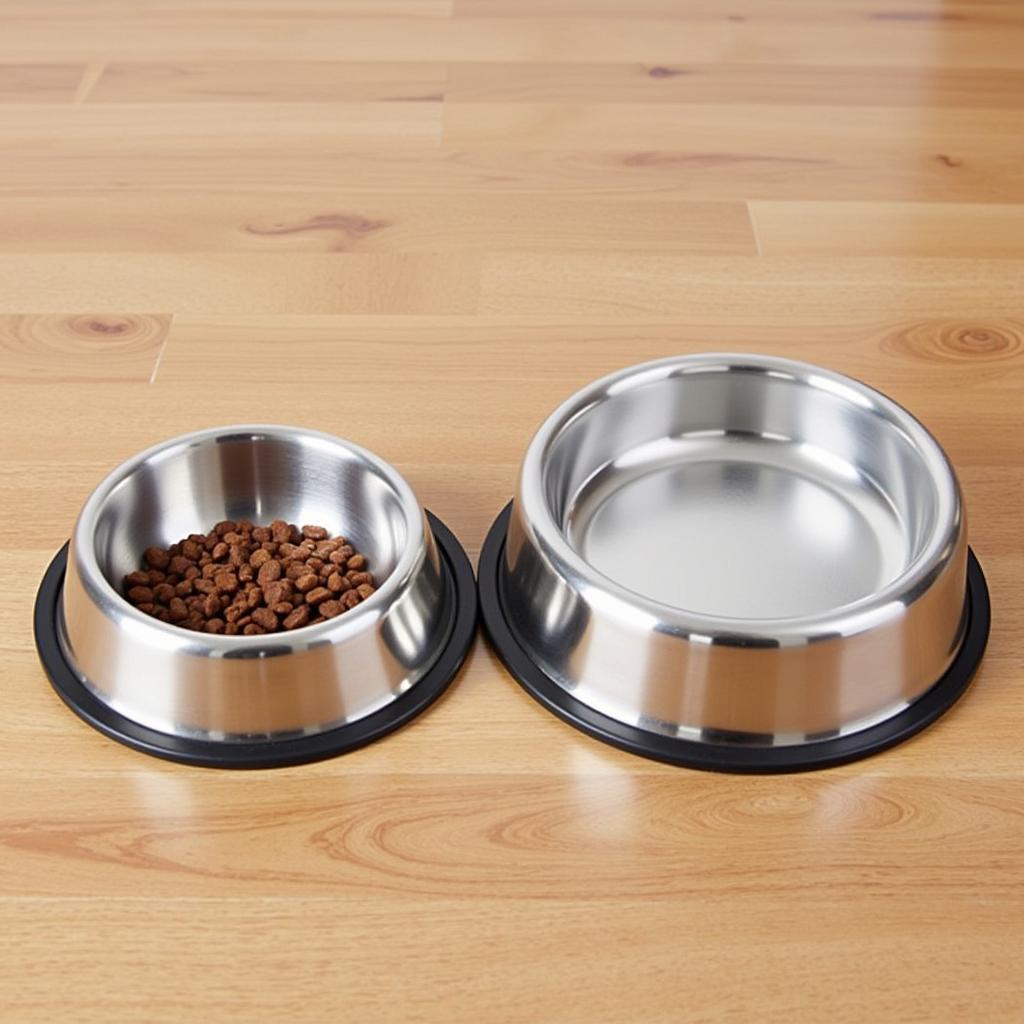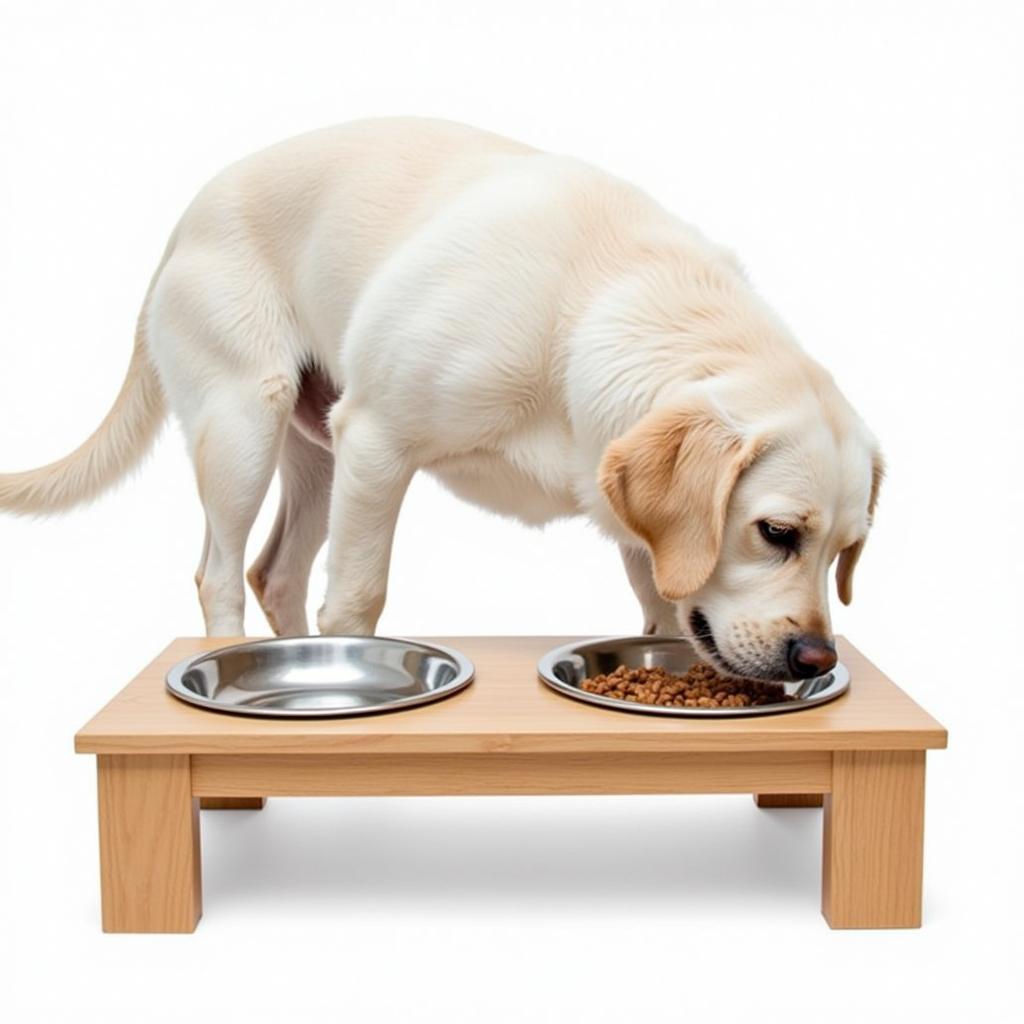Choosing the right Dog Water And Food Bowl might seem like a simple task, but it can significantly impact your furry friend’s health and happiness. From size and material to design and placement, there are several factors to consider to ensure your canine companion enjoys their meals and stays properly hydrated.
Why the Right Dog Water and Food Bowl Matters
Just like humans, dogs have specific needs when it comes to eating and drinking. The wrong bowl can lead to a range of issues, including:
- Spills and messes: Bowls that are too small or shallow can easily tip over, creating a mess around your home.
- Eating difficulties: Deep bowls might make it challenging for some dogs, especially those with short snouts or flat faces, to reach their food comfortably.
- Health concerns: Plastic bowls can harbor bacteria and trigger allergies, while some materials can react with food and affect its taste.
- Joint pain: For senior dogs or those with joint issues, elevated bowls can ease strain on their neck and joints during mealtime.
Choosing the Perfect Dog Water and Food Bowl: Factors to Consider
Navigating the world of dog bowls can feel overwhelming with so many options available. Here’s a breakdown of the essential factors to consider:
1. Size Matters: Matching Bowl Size to Your Dog
The first step is to choose a bowl size that suits your dog’s breed and eating habits. A good rule of thumb is to measure your dog’s height at the shoulder and select a bowl with a rim slightly lower.
- Small breeds: Opt for shallow, small-capacity bowls to prevent food spillage and ensure easy access.
- Medium to large breeds: Deeper and wider bowls can accommodate larger food portions and prevent whisker fatigue.
- Giant breeds: Consider elevated feeders or bowls with stands to promote better posture and reduce strain on their neck.
2. Material Matters: Prioritizing Durability and Safety
The material of your dog’s bowl directly impacts their health and hygiene.
- Stainless steel: Durable, hygienic, dishwasher-safe, and resistant to bacteria growth, making it a top choice for many dog owners.
 Stainless Steel Dog Bowls
Stainless Steel Dog Bowls - Ceramic: Often stylish and available in various designs, ceramic bowls are easy to clean and generally safe for dogs. However, they can be prone to chipping or breaking.
- Glass: Non-porous and easy to clean, glass bowls are a good option but can be fragile and require careful handling.
- Plastic: While affordable, plastic bowls can harbor bacteria and scratches, making them less hygienic. Avoid plastic if your dog tends to chew on their bowls.
3. Design and Features: Enhancing Comfort and Convenience
Beyond the basics, consider these design features to enhance your dog’s mealtime experience:
- Non-slip base: Prevents spills and allows your dog to eat without chasing their bowl around the floor.
- Elevated feeders: Promote better digestion and reduce strain on joints, especially beneficial for senior dogs or those with arthritis.
 Elevated Dog Feeder
Elevated Dog Feeder - Slow feeders: Specially designed bowls with ridges or obstacles to slow down fast eaters and prevent bloating.
- Travel bowls: Collapsible or portable bowls are perfect for on-the-go hydration and feeding during walks, hikes, or trips.
Water, Water Everywhere: Keeping Your Dog Hydrated
Providing constant access to fresh, clean water is crucial for your dog’s overall health.
- Choose the right water bowl: Opt for a large-capacity bowl, especially for larger breeds, to avoid frequent refills.
- Consider a water fountain: Flowing water can entice picky drinkers and encourage increased water intake.
- Refresh water regularly: Change the water at least twice a day and wash the bowl regularly to prevent bacteria growth.
- Monitor water intake: Be aware of your dog’s drinking habits. Changes in water intake can indicate potential health issues.
FAQs about Dog Water and Food Bowls
Q: How often should I clean my dog’s bowls?
A: Ideally, wash your dog’s food and water bowls daily with warm soapy water. Stainless steel and ceramic bowls are dishwasher safe for added convenience.
Q: My dog eats too fast. What kind of bowl can help?
A: Slow feeder bowls are specifically designed with ridges or mazes to slow down fast eaters and prevent bloating and indigestion.
Q: Are elevated feeders really better for dogs?
A: Yes, elevated feeders can be particularly beneficial for senior dogs, large breeds, or dogs with joint issues as they promote better posture and reduce strain on their neck, back, and joints while eating.
Q: Can I use human bowls for my dog?
A: While you can technically use human bowls, it’s generally recommended to choose bowls specifically designed for dogs. Dog bowls are often made with durable materials and come in appropriate sizes and depths to suit their eating habits.
Q: My dog is allergic to plastic. What’s the best alternative?
A: Stainless steel is a great hypoallergenic option for dogs with allergies. It’s durable, hygienic, and doesn’t harbor allergens like some plastics.
Need More Help?
Choosing the right dog water and food bowl is an important decision that can significantly impact your furry friend’s well-being. For personalized advice or if you have further questions, our team at Mina Cones Food is here to help! You can reach us at 02437655121, email us at [email protected], or visit us at 3PGH+8R9, ĐT70A, thôn Trung, Bắc Từ Liêm, Hà Nội, Việt Nam. Our dedicated customer support team is available 24/7 to assist you. You might also find helpful information in our other articles, such as “Dog Throwing Up Undigested Food Right After Eating” or “Hypoallergenic Dog Food Recipe”.